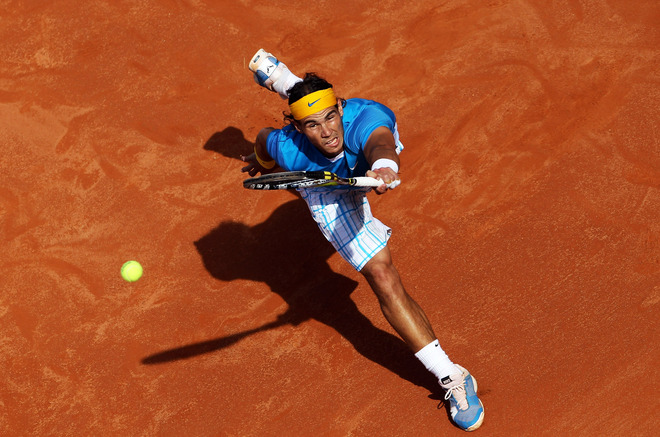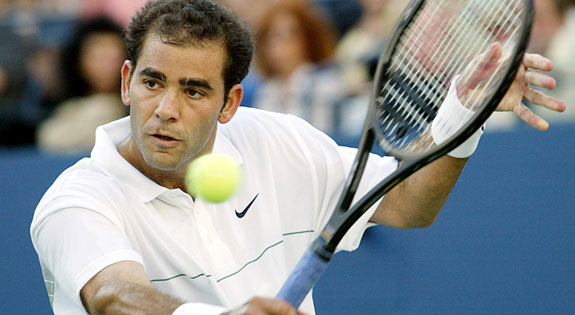Rafa Nadal was fist-pumping and gyrating all over the court in celebration after this excruciating semifinal, a 6-4, 3-6, 6-4 triumph over ball-crushing Ernests Gulbis that seemed headed for a very dangerous third-set tiebreak, and you knew from Rafa’s post-match exhileration that he was particularly happy to get out of this one.
It was a final-four match at Rome that was significant for a few reasons. For Nadal, it pushed him to his 10th consecutive win on clay this year without a loss and into his second final, to play amigo David Ferrer, following his dominance at Monte Carlo two weeks ago. It also demonstrated, once again, his resilience and resourcefulness in dealing with a hot opponent. At 23, Nadal still doesn’t get enough credit for his ability to make adjustments in mid-match.
For Gulbis, who had taken out Roger Federer in the second round, it raised a pretty important question: Just how good is this guy?
His ranking of No. 40 will improve significantly when the ATP computer spits out the new list on Monday morning and, after what he has shown these last few weeks, there are a lot of people wondering if he’s top-10, even top-5 material. His ball contact is so impeccable that, even on clay, his ground strokes are lethal from just about any position on court.
As for foot speed? Good enough. Guts and heart? “I (bleeped) in my pants,” he said after confronting match points against Federer last week — a remark that will be remembered, humorously, for a long time. But he never choked. Was it Rod Laver who said that when he felt tight on court, he didn’t let up but, rather, just hit harder. That appears to be Gulbis’ philosophy as well, though he made a couple of fatal drop shot mistakes in the final game of the Nadal match, which we’ll get into in a moment.

This was a match with just three service breaks — one in each set. Nadal defended his serve with pinpoint accuracy and his ability to back it up by taking charge of points early. Gulbis, meanwhile, defended his serve with pace — an average 121 mph on first serve. Maybe that doesn’t seem particularly high, but when you factor in those slice serves to the deuce court which require less speed to be effective, 121 is Andy Roddick territory.
Gulbis presents opponents with two major difficulties. One is his first serve, which he got in an extraordinary 77 percent of the time, even at such high pace. The other is his ground stroking. He’s going for the lines and he’s not waiting for a high-percentage situation. Actually, a high-percentage situation for Gulbis is any ball he can get a shoulder turn on. He had 50 winners and 53 unforced errors in this semifinal, and that’s typical of the risk with which he plays.
But as good as his first serve is, the second is a liability against better players. The pace on that second serve is a lot better than the location, and, as the third set wore on and Nadal searched for ways to earn the crucial break, he repeatedly took advantage of the few second serves he was offered. If Gulbis is to break top 10 he’s going to have to get better on that second. He’s also going to have to steady down his shot selection at crunch time, though he’s doing a much better job of that under new coach Hernan Gumy.
Serving to stay in the match at 4-5 in the third, Gulbis inexplicably settled on a couple of drop shots on the first two points. Nadal was all over both — easily. Rafa then made a couple of remarkably returns off first serves to close it out at love. And was he happy to get out of there.
One of the best things Nadal did in the third set was to get more topspin on his returns to Gulbis’ backhand side. The Latvian clearly was not as comfortable with high balls off his left as he is off the forehand side. Once Rafa was able to force cross-court rallies between his (left-handed) forehand and Gulbis’ backhand, he was in command. Where Gulbis’ forehand does not break down in long rallies, his backhand does.
He’s fun to watch because he gives you a lot of gestures and body language, but he’s also a bit tiresome as you watch him go to the towel after every service point, wiping a forehand that looks completely dry. This is classic Greg Rusedski time-wasting, but, then, Nadal can push the clock between points, too.
Gulbis admits that he wasn’t always fully committed to his training, but that he is now. If he continues this kind of play, he’ll be a factor at the French Open and certainly one at Wimbledon and the U.S. hardcourt season this summer.
Charles Bricker can be reached at nflwriterr@aol.com

